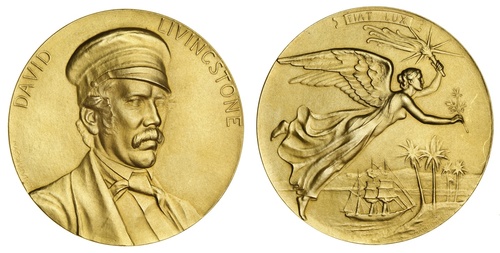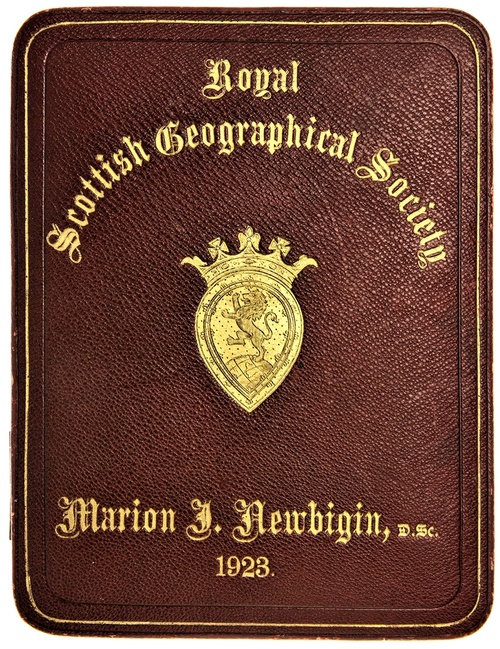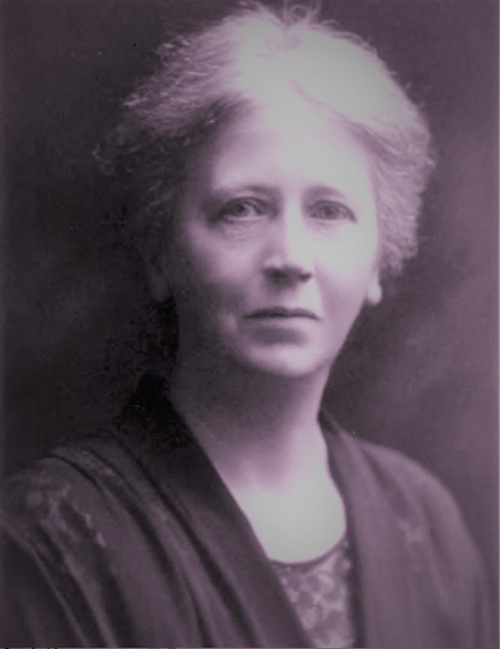Auction: 19007 - Coins and Commemorative Medals: Winter Auction
Lot: 412
"She was rather one of the quiet inspirers, not linked with any great feats, but confident in her own abilities, fascinated by the natural world, and passionate about kindling the fire of fascination in others. It is impossible to tell how many young explorers gained their first taste of geography from her words". Royal Scottish Geographical Society, David Livingston Prize Medal, 1923, in gold, by P. MacGillivray, for Kirkwood and Sons, Edinburgh, capped bust of Livingstone right, signed
"This Livingstone Medal presented to the late Dr Marion Newbigin was left by her to the R.S.G.S and ordered to be sold by the Society in aid of the Newbigin Fund. It was purchased by me from the Society for £60.0.0, which was the highest offer obtained from any dealer, the lowest being for £45.0.0 from the medallists Messrs. Kirkwood and Sons. It is held mean time by me in memory of its late owner and editor of the [Scottish Geographical] Magazine. John Bartholomew, December 1947".
~and thence by descent to the present owners who have ordered its sale once more for the benefit of the Royal Scottish Geographical Society~
Marion Isabel Newbigin was born at Alnwick, Northumberland in 1869, one of five daughters of a local pharmacist. As a biographer latterly put it, soon after began her contribution to 'a sphere largely populated by men, and a lifetime of work that helped to define the study of geography'. Marion would benefit from her father's unusually progressive stance on education, encouraging her three brothers to pursue careers and independence during their formative years, whilst being equally supportive of her and her sisters in pursuing all possible avenues of education, however limited they were for girls in the latter quarter of the 19th Century.
Engaging with the Edinburgh Association for the University Education of Women, Marion passed her matriculation exams in 1890 and was accepted to study at the University of London, one of the few schemes to allow female students at the time. The following year, aged 22, Marion enrolled at the University of Aberystwyth. engaging in all theatres of science, from mathematics to chemistry, biology to physics. In 1893, she was awarded her BSc in Zoology, and five years later obtained her DSc from the same institution, becoming only its second ever female student to achieve the feat.
Following graduation, Marion found a position amongst scientists at Millport Marine Biological Station analysing and recording data obtained from the groundbreaking Challenger Expedition around the world between 1872 and 1876. She would undertake new research into the natural pigments of plants and animals and eventually publish a book on the subject, entitled: 'Colour in Nature: A Study in Biology'.
Upon the encouragement of James Geikie, Professor of Geology at the University of Edinburgh, Newbigin took up post as editor of the Scottish Geographical Magazine, the publication arm of the Royal Scottish Geographical Society. Her 'bercovian' approach to submissions ensured that the developing field of scientific newcomers would provide regular content to the magazine. Marion also contributed, penning such forward-thinking articles as 'Ice Ages and the Geographical History of Climate'.
The evolution of women's suffrage in the early 20th Century did not pass many, and especially not Newbigin, by unnoticed. In 1916, she was part of the successful movement pressuring the University of Edinburgh to allow female students into all aspects of medical studies. Similarly, Marion aimed to challenge matters of Empire and the emerging politicisation of race, by delineating her writings with a focus on the anthropological aspects of geography and human habitation. Never marrying and having no children allowed Marion to live and teach by her mantra of learning, and to seek out education wherever it could be found. Consequently she argued for teachers to 'be content to open doors', and as aspiring travellers, try not to be bogged down in 'ceaseless journalistic chatter about colonies and dependencies'. In 1923, the Royal Scottish Geographical Society recognised her 'numerous contributions to geographical science' by presenting her this medal, the first female recipient of this prestigious award. Towards the end of her life, she shared her home with two of her sisters. It was here on the 20 July 1934, the date of the RSGS's 50th Anniversary celebration, that she was sadly found to have passed away. The Newbigin Prize for outstanding contributions to RSGS publications was subsequently set up in her memory. This medal was sold to Mr Bartholomew by the Society in order to help fund her legacy prize, and so it is quite apt that the medal reappears again today with the intention of being sold for the benefit of the same philanthropic pursuit and providing some much welcomed funding for the commissioning of future publications for the mass education of children about the subject of Geography.
Subject to 20% VAT on Buyer’s Premium. For more information please view Terms and Conditions for Buyers.
Sold for
£6,000
Starting price
£6750









